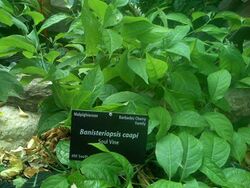Banisteriopsis caapi
Banisteriopsis caapi, also known as ayahuasca, caapi or yagé, is a South American liana of the family Malpighiaceae. It is used to prepare ayahuasca, a decoction with a long history of its entheogenic use and its status as a "plant teacher" among the indigenous peoples of the Amazon rainforest.
| Banisteriopsis caapi | |
|---|---|
 |
|
| Taxonomical nomenclature | |
| Kingdom | Plantae |
| Unranked | Angiosperms |
| Unranked | Eudicots |
| Unranked | Rosids |
| Order | Malpighiales |
| Family | Malpighiaceae |
| Genus | Banisteriopsis |
| Species | B. caapi |
| Common nomenclature | |
| Common names | Ayahuasca, Caapi or Yagé |
| Constituents | |
| Active constituents | Harmala alkaloid |
History and culture
Research
The alkaloids of Banisteriopsis caapi, the plant source of the Amazonian hallucinogen ayahuasca, stimulate adult neurogenesis in vitro.[1]
Chemistry
Banisteriopsis caapi (also known as ayahuasca, caapi or yajé) is a South American jungle vine of the family Malpighiaceae. It contains harmine, harmaline, and tetrahydroharmine in the following proportions:
- Harmine: 0.31-8.43%
- Harmaline: 0.03-0.83%
- Proanthocyanidins (less known MAOIs)
- (−)-epicatechin
- (−)-procyanidins
- Tetrahydroharmine: 0.05-2.94%
Toxicity and harm potential
Dangerous interactions
Cholinergics
Cholinergic substances combined with Banisteriopsis caapi can cause a cholinergic crisis because the plant contains acetylcholinesterase inhibitors (AChEIs):
See also
External links
- Harmala alkaloids
Literature
- Morales-García, J. A., de la Fuente Revenga, M., Alonso-Gil, S., Rodríguez-Franco, M. I., Feilding, A., Perez-Castillo, A., & Riba, J. (2017). The alkaloids of Banisteriopsis caapi, the plant source of the Amazonian hallucinogen Ayahuasca, stimulate adult neurogenesis in vitro. Scientific Reports, 7(1), 5309. https://doi.org/10.1038/s41598-017-05407-9